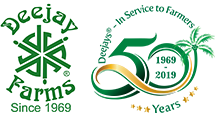A coconut breeding project involves
-
The identification of the right level of immaturity of the flower spathe in the dwarf mother palm.
-
Manually cutting it open to remove every male flower (10,000 plus) in the spathe, without damaging or touching the female buttons.
-
Scratching the date of emasculation on each leaf stem for the record and easy interpretation of growth in the months to come.
-
Spraying a protective coat of insect retardants.
-
Separately preparing little vials of pollen collected from selected Tall palms, processed in and sent from our laboratory in our estate in Madurai under special conditions to preserve the viability.
-
Manually brush pollinating the female buttons after some days when they mature, one button at a time over a period of 7 to 10 days, as each button matures, requiring a person to visit or climb the tree each time.
-
Counting the number of buttons for the computerized record of every palm – i.e. “Button count”.
-
Checking the button count after 120 days for the record and for estimation of production of seed nuts and seedlings in the future.
-
This may be repeated approx 18 times or more per mother palm per month for every spathe that emerges from every leaf.
-
Nuts are harvested depending on the season and the level of maturity of the nut between 11 months and 13 months of age. The records of every single tree are maintained separately and monthly.
For the generation of the next-gen Mother stock
-
The computer selects the 2% best mothers dwarfs based on productivity taking the average production of the last six years, from among approx 30,000 adult palms each with records that have been computerized.
-
These 600 highest producing palms are then individually scrutinized, For – their Tree Characteristics – the age at first flowering [to gauge early production], the number of leaves, the strength of the attachment of the leaf to the palm trunk, for the height of the palm [shortness is preferred over tallness], the number of leaves, the number of leaflets, the length, breadth and the number of leaflets. The nut characteristics – the weight of the nut husked and dehusked, the thickness of the shell, the thickness of the kernel, the weight of the copra, the oil percentage, etc.
-
Just a fraction of this number of 600 is finally selected, numbered, and tagged. These become the “Grand Mothers” of the next generation of mothers.
-
From this list, the very best palms are selected to be used as Fathers of the dwarf mother line – which is called in-breeding for the concentration of preferable characteristics.
-
The pollen of the Father Palms are harvested and carefully processed, bottled, and labeled, preventing a mix up of the pollen.
-
Several families are created headed by one [and among the very exclusive best ‘fathers’] Male palm, for pedigreed pollination of the female palms in the family. Every nut is recorded and tagged with a fail-proof tag. The tag has the code of its pedigree secured in the computerization process.
-
At maturity, nuts are harvested and planted mother-wise and family-wise.
-
Records at all levels are maintained and the pedigreed seedlings are again tagged and recorded where and when they are planted’
-
They are used in the Continuous Improvement Plan or CIP.
